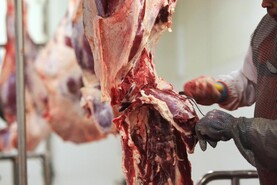Management in Newford Farm is obviously now focused on indoor management and ensuring stock performance is on target.
The majority of cows are on a maintenance diet and receiving ad-lib silage, which tested in the mid-60s for dry matter digestibility (DMD).
A batch of 24 cows comprising mainly first- and second-calvers and a few cows which reared twins are falling below target body condition score (BCS) and as such are receiving preferential treatment.
Significant benefits
The cows in question are receiving 2kg soya hulls daily. This practice has taken place in previous years and has delivered significant benefits, with research showing the way cows are managed during mid- and late pregnancy can have a big influence on reproductive performance post-calving.
The BCS of cows is being monitored regularly by farm manager Iarlaith Collins and once cows reach target BCS, they will be removed from the preferential treatment group or feeding will cease to the pen in question.
One cow unfortunately aborted last week
All cows are also receiving 100g of a pre-calving mineral daily and this is being spread on top of silage.
One cow unfortunately aborted last week. She was removed from the group and isolated as a precaution. She will remain in isolation until the results of the calf post-mortem are received.
It is likely it may be injury-related rather than an infectious agent, but no chances are being taken.
Weanlings

Weanlings appear to be performing well and will be weighed next week to monitor performance since housed.
Weanlings appear to be performing well on a diet of 74DMD silage and 2kg concentrate supplementation. They have previously received a fluke and worm dose and treatment for lice, which was applied after their backs were clipped.
They will be weighed next week, with weights analysed by Michael Fagan of Teagasc, who is working with the herd to ensure they are on target to hit an average daily liveweight gain of 0.6kg to 0.7kg.
Read more
BEAM scheme payments have begun for farmers
Beef Management: soil fertility and scour vaccines- timing is key
Management in Newford Farm is obviously now focused on indoor management and ensuring stock performance is on target.
The majority of cows are on a maintenance diet and receiving ad-lib silage, which tested in the mid-60s for dry matter digestibility (DMD).
A batch of 24 cows comprising mainly first- and second-calvers and a few cows which reared twins are falling below target body condition score (BCS) and as such are receiving preferential treatment.
Significant benefits
The cows in question are receiving 2kg soya hulls daily. This practice has taken place in previous years and has delivered significant benefits, with research showing the way cows are managed during mid- and late pregnancy can have a big influence on reproductive performance post-calving.
The BCS of cows is being monitored regularly by farm manager Iarlaith Collins and once cows reach target BCS, they will be removed from the preferential treatment group or feeding will cease to the pen in question.
One cow unfortunately aborted last week
All cows are also receiving 100g of a pre-calving mineral daily and this is being spread on top of silage.
One cow unfortunately aborted last week. She was removed from the group and isolated as a precaution. She will remain in isolation until the results of the calf post-mortem are received.
It is likely it may be injury-related rather than an infectious agent, but no chances are being taken.
Weanlings

Weanlings appear to be performing well and will be weighed next week to monitor performance since housed.
Weanlings appear to be performing well on a diet of 74DMD silage and 2kg concentrate supplementation. They have previously received a fluke and worm dose and treatment for lice, which was applied after their backs were clipped.
They will be weighed next week, with weights analysed by Michael Fagan of Teagasc, who is working with the herd to ensure they are on target to hit an average daily liveweight gain of 0.6kg to 0.7kg.
Read more
BEAM scheme payments have begun for farmers
Beef Management: soil fertility and scour vaccines- timing is key







 This is a subscriber-only article
This is a subscriber-only article










SHARING OPTIONS: